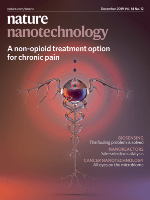
Nature Nanotechnology
Scope & Guideline
Bridging Disciplines for a Nanotech Revolution.
Introduction
Aims and Scopes
- Nanomaterials and Nanostructures:
Research on the synthesis, characterization, and application of nanomaterials, including metals, semiconductors, and biomaterials, focusing on their unique properties at the nanoscale. - Nanomedicine and Therapeutics:
Exploration of nanotechnology in medical applications, including drug delivery systems, diagnostic tools, and therapeutic strategies aimed at improving health outcomes. - Nanoelectronics and Photonics:
Development of nanoscale electronic and photonic devices, investigating how nanoscale phenomena can enhance device performance and functionalities. - Environmental and Sustainable Nanotechnology:
Studies addressing the environmental impact of nanomaterials and the development of sustainable nanotechnology solutions for energy, catalysis, and pollution remediation. - Quantum and Topological Nanostructures:
Research on quantum phenomena in nanostructures, including topological insulators and their potential applications in quantum computing and information processing.
Trending and Emerging
- Smart Nanomaterials and Responsive Systems:
There is a significant increase in research focused on developing smart nanomaterials that can respond to environmental stimuli, enhancing their functionality in applications such as drug delivery, sensors, and environmental remediation. - Nanotechnology for Sustainable Energy Solutions:
Emerging studies are increasingly focusing on the role of nanotechnology in renewable energy, including solar cells, energy storage systems, and catalytic processes for carbon capture. - Personalized Nanomedicine and Targeted Therapies:
Research aimed at customizing nanomedicine approaches for individual patients is rapidly growing, particularly in cancer treatment, where targeted delivery systems are being optimized. - Integration of Artificial Intelligence in Nanotechnology:
The application of AI and machine learning in the design, synthesis, and characterization of nanomaterials is emerging as a significant trend, enhancing the efficiency of research and development. - Quantum Technologies and Information Processing:
There is a growing focus on the development of quantum nanostructures and devices that leverage quantum properties for applications in computing, cryptography, and communication.
Declining or Waning
- Classical Materials Engineering:
Research focused on traditional materials engineering approaches (e.g., bulk material properties) has seen a decline as the focus shifts towards nanoscale phenomena and applications, which offer more innovative solutions. - Conventional Drug Delivery Systems:
The exploration of traditional drug delivery methods is decreasing as interest grows in novel nanocarrier systems that enhance specificity and efficacy, particularly for personalized medicine. - General Nanotoxicology Studies:
While the safety of nanomaterials remains important, the volume of general studies on nanotoxicology has decreased, with a shift towards more specific and mechanistic investigations. - Static Nanostructure Analysis:
Research that primarily focuses on static properties of nanostructures is declining, with a growing emphasis on dynamic behaviors and real-time applications. - Broad-spectrum Biomedical Applications:
Research that lacks specificity in biomedical applications is declining as the field moves towards targeted therapies and precision medicine strategies.
Similar Journals
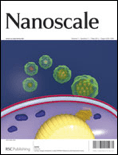
Nanoscale
Exploring Breakthroughs in Nanoscale Research.Nanoscale is a premier academic journal published by the Royal Society of Chemistry, dedicated to advancing the field of nanoscience and nanotechnology. With both its ISSN (2040-3364) and E-ISSN (2040-3372) ensuring wide accessibility, the journal is renowned for its high-impact research contributions, reflected in its impressive 2023 Impact Factor and prestigious Q1 ranking in both Materials Science (Miscellaneous) and Nanoscience and Nanotechnology categories. Since its inception in 2009, Nanoscale has fostered a collaborative platform where leading researchers from around the globe share their innovative findings across a multitude of topics spanning from material synthesis to applications in nanotechnology. The journal not only serves as a valuable resource for professionals, researchers, and students but also actively engages the academic community in discussing emerging trends, thus shaping the future of nanoscience. Situated in the heart of the UK at Thomas Graham House, Science Park, Milton Rd, Cambridge CB4 0WF, Nanoscale remains a key publication for those looking to keep abreast of the latest breakthroughs in an ever-evolving field.

Physical and Chemical Aspects of the Study of Clusters Nanostructures and Nanomaterials
Advancing Understanding of Nanostructures and Their ImpactPhysical and Chemical Aspects of the Study of Clusters, Nanostructures, and Nanomaterials is an esteemed open-access journal published by TVER STATE UNIVERSITY, dedicated to advancing the scientific discourse surrounding the intricate interplay of physical and chemical properties in nanostructure materials. Launched in 2017, this journal provides a vital platform for researchers, professionals, and students to disseminate and access cutting-edge findings in the rapidly evolving fields of nanotechnology and materials science. With an ISSN of 2226-4442 and an E-ISSN of 2658-4360, it aims to bridge the gap between academic research and practical applications. By facilitating open access to high-quality research, the journal plays an essential role in promoting innovative solutions to contemporary challenges in engineering, materials development, and related industries. The journal's scope includes but is not limited to the synthesis, characterization, and functionalization of nanomaterials, ensuring comprehensive coverage of this multidisciplinary field.
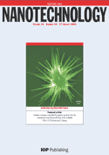
NANOTECHNOLOGY
Connecting Science and Engineering at the Nanoscale.NANOTECHNOLOGY is a premier academic journal published by IOP Publishing Ltd, focusing on cutting-edge advancements in the interdisciplinary field of nanoscience and nanotechnology. With a strong emphasis on research that bridges biology, chemistry, engineering, and materials science, this journal presents high-quality, peer-reviewed articles that cater to the diverse interests of researchers, professionals, and students alike. NANOTECHNOLOGY boasts an impressive ISSN: 0957-4484 and E-ISSN: 1361-6528, and holds a notable position within Scopus, ranked in the second quartile (Q2) across multiple categories including Bioengineering and Mechanical Engineering, underscoring its vital role in advancing the field. The journal's impact is further highlighted by its robust rankings, making it essential reading for those looking to stay at the forefront of nanotechnology research. Commencing in 1990 and with publication extending through to 2024, NANOTECHNOLOGY provides a unique platform for disseminating significant findings and innovative methodologies while fostering collaborations across various scientific disciplines. In a rapidly evolving technological landscape, this journal not only enhances academic discourse but also contributes to the practical applications of nanotechnology in real-world scenarios.

Nanoscale Research Letters
Shaping the future through nanoscale discoveries.Nanoscale Research Letters, published by SPRINGER, is a leading open-access journal dedicated to the rapid dissemination of innovative research in the field of nanoscience and nanotechnology. Established in 2006, this journal provides researchers and professionals with a platform to share their groundbreaking findings across a broad spectrum of applications, including condensed matter physics and materials science. With an impressive Q1 ranking in both Condensed Matter Physics and Materials Science categories as of 2023, it asserts its position as a top-tier publication within the scientific community, bolstered by a 96th percentile rank in the Scopus database. Nanoscale Research Letters not only emphasizes the importance of nanotechnology research but also ensures that its findings are widely accessible, adhering to its open-access mandate. Scholars and students alike are encouraged to contribute to and engage with this dynamic resource, fostering collaboration and innovation in the ever-evolving world of nanoscience.

Microfluidics and Nanofluidics
Exploring Innovative Pathways in Fluid DynamicsMicrofluidics and Nanofluidics is a distinguished academic journal published by Springer Heidelberg, focusing on the rapidly evolving fields of micro and nanotechnology. With a commitment to disseminating cutting-edge research, this peer-reviewed journal aims to bridge the gap between fundamental science and practical application within Condensed Matter Physics, Materials Chemistry, and Nanoscience and Nanotechnology. It holds an influential position in its field, reflected by its Category Quartiles (Q3) and notable Scopus Rankings, including a ranking of #145 in Condensed Matter Physics. Researchers, professionals, and students will find this journal to be an invaluable resource for accessing pioneering studies, methodologies, and innovative technologies essential for advancing knowledge and applications in micro and nanofluidics. With an extensive history from 2004 to 2024, Microfluidics and Nanofluidics continues to foster discussion and collaboration within the scientific community, solidifying its role as a leading platform for scholarly communication in this dynamic discipline.
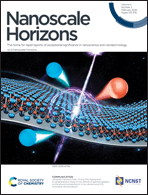
Nanoscale Horizons
Pioneering Discoveries in NanotechnologyNanoscale Horizons is an esteemed journal published by the Royal Society of Chemistry, focusing on cutting-edge research in the field of nanoscale materials and their applications. Established in 2016, this journal quickly gained prominence, achieving a Q1 ranking in Materials Science (miscellaneous) and a notable rank of #32 out of 463 in the Scopus index, placing it in the 93rd percentile among its peers. With its rigorous peer-review process and commitment to disseminating high-impact research, Nanoscale Horizons serves as a vital platform for sharing innovative discoveries and interdisciplinary advancements. Researchers and professionals are invited to explore the exciting developments in nanotechnology through this publication, fostering collaboration and knowledge exchange in an ever-evolving field. Though currently not open access, the journal ensures that significant research findings are made available to a diverse audience keen on advancing materials science.
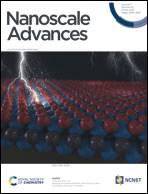
Nanoscale Advances
Advancing the Frontiers of Nanoscience.Nanoscale Advances, published by the Royal Society of Chemistry, stands out as a leading open-access journal dedicated to advancing the field of nanoscience and nanotechnology since its inception in 2018. With a specialized focus on areas such as atomic and molecular physics, bioengineering, chemistry, and materials science, this journal has consistently achieved top-tier rankings across several categories, reflecting its high-impact contribution to research and innovation. Currently classified in the Q1 quartile for both Atomic and Molecular Physics and Chemistry (Miscellaneous), and Q2 for Bioengineering, its prestige is underscored by impressive Scopus rankings, including a notable 34th position in General Engineering. With its commitment to disseminating high-quality research, Nanoscale Advances serves as an invaluable resource for researchers, professionals, and students alike, fostering collaboration and scholarly exchange in the rapidly evolving landscape of nanotechnology.

International Journal of Nanoscience
Transforming Ideas into Nano-Scale RealitiesThe International Journal of Nanoscience, published by WORLD SCIENTIFIC PUBL CO PTE LTD, stands as a significant platform in the multidisciplinary field of nanoscience and nanotechnology, offering a unique insight into innovative research developments and applications from 2004 to 2024. Based in Singapore, this journal provides an academic space for researchers, professionals, and students to explore the latest advancements across its wide-ranging scopes, which include bioengineering, biotechnology, computer science applications, condensed matter physics, electrical engineering, and materials science. While currently categorized in Q4 quartiles across multiple fields, the journal's commitment to quality research and scholarly discourse positions it as a pivotal resource for driving forward the understanding and application of nanoscience. Despite its non-open access format, the journal invites subscriptions from institutions and individuals eager to stay ahead in this rapidly evolving discipline. By fostering an environment of collaboration and innovation, the International Journal of Nanoscience aims to contribute significantly to the body of knowledge essential for future breakthroughs in science and technology.

Nano Futures
Exploring the Boundaries of Nanoscale InnovationNano Futures, published by IOP Publishing Ltd, is an influential journal dedicated to advancing the field of nanoscale science and technology, encompassing a wide range of disciplines such as Atomic and Molecular Physics, Bioengineering, and Materials Science. With a growing impact within the academic community, this journal has achieved a notable Q2 classification in categories like Chemistry and Electrical Engineering, making it a critical resource for researchers, professionals, and students seeking to explore innovative advancements in nanotechnology. Established in 2017 and operating through 2024, Nano Futures provides open access options for readers, ensuring wider dissemination and engagement with cutting-edge research findings. The journal's commitment to showcasing high-quality research makes it an essential channel for exploring the intersection of nanoscale innovations and practical applications in various industries.

Nano Research
Pioneering discoveries in nanotechnology.Nano Research, published by TSINGHUA UNIVERSITY PRESS, is a prestigious academic journal dedicated to advancing the fields of nanoscience and nanotechnology. Since its inception in 2009, the journal has established itself as a leading platform for the dissemination of high-quality research, evidenced by its impressive Q1 rankings across multiple categories including Atomic and Molecular Physics, Condensed Matter Physics, and Electrical and Electronic Engineering. With an impact that resonates globally, Nano Research not only attracts contributions from renowned researchers but also appeals to students and professionals striving to stay at the forefront of innovation. The journal’s commitment to excellence is reflected in its ranking, placing it in the top echelons of its field, as evidenced by its notable Scopus standings. Researchers can benefit from its rigorous peer-review process and broad scope, encompassing theoretical, experimental, and applied studies. For those passionate about pushing the boundaries of knowledge in the realm of nanotechnology, Nano Research serves as an indispensable resource.